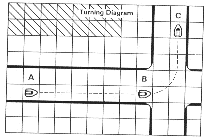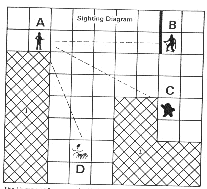Skimmers are similar to automobiles, but have protected hoverfans instead of wheels. They float on a cushion of air 30 centimeters (about 1 foot) above the ground. A skimmer can hold up to five passengers.
Skimmers have a maximum speed of 10 squares per turn, and must stay on the roads (except when parked). A character can get into a skimmer on the same turn he moves into the skimmer's square, but the skimmer cannot move that turn. On the next turn, the skimmer can move up to 3 road squares. It can move its full 10 squares on the following turn.
Skimmers must slow down when they turn or move through an intersection. (Magnetic field generators built into the roads automatically reduce the speed of approaching vehicles.) A skimmer can move only 5 squares if it turns or moves through an intersection during its movement. If a skimmer is in the middle of an intersection or turning a corner at the start of its move, it can move only 5 squares.
EXAMPLE: A skimmer traveling at a speed of 10 is seven spaces away from a corner (position A). The skimmer must reduce its speed to seven and stop just short of the corner (position B). On the next turn it can move five squares and turn the corner (position C). On the following turn it can move at full speed.

Rental Skimmers. Skimmers can be rented for 10Credits per day. To get a rental skimmer, a character must move next to the road and signal for one with his communicator. The skimmer, being driven by a computer, will arrive two turns later. The charaaer can get into the skimmer on the turn it arrives, but can't move till the next turn. The character who is driving the skimmer must have his ID card.
Underground Parking. Most buildings in Port Loren have underground parking garages for skimmers. Characters must use the entrance ramps to get into or out of these areas. Skimmers can drive through these areas at a speed of 5 squares per turn or less. Characters can walk or run through these areas at normal speeds.
Characters are in combat whenever at least one of them is attacking another in any way. Guns and grenades are the most common weapons. Two of a character's abilities are important in combat: Dexterity and Stamina. A character's Dexterity score determines his chance to hit a target. A character's Stamina score is the number of points of damage the character can take before passing out.
A grenade will stop if it hits a wall or other obstacle.
EXAMPLE: Eusyl is throwing a doze grenade from long range. The grenade misses its intended square. Dave Schick rolls 1 d10 and gets a 5. The grenade bounces 3 squares directly to the right of the target square. and then goes off. If anyone was in that square, theywould be knocked out by the gas.
The effect of a doze grenade is described under Damage.
Automatic Hits
A roll of 01 to 05 always is a hit, regardless of mod)fiers, if the target is visible and in range. For example, if a characterwith a Dexterity score of 35 shoots at a target at Extreme range, his chance to hit is -45%. However, if the character rolls 01 to 05 on percentile dice, he hits the target anyway.
Cover
Cover is any solid object that can protect someone from gunfire. A character who is partially hidden by a wall, a rock, a skimmer, etc., has cover. A character has cover if he is in any of the following situations:
1. The character is in a space containing a monorail pylon, a statue, trees, low walls, large rocks or a parking area entrance ramp.
2. The character is inside a building. This applieswhetherthe character is fighting opponents who are also inside the building or is standing next to a door or window and shooting at targets outside.
3. The character is standing near the corner of a building, in a position that lets him lean around the corner to shoot at a target.
4. The character is standing on a pedestrian walkway.
5. The character is riding in a skimmer.
Vehicles
A character who is riding in a skimmer can fire a weapon, but has a -10 modifier for moving (the same as if the character were running). A character who is driving a skimmer cannot shoot a gun.
All characters who are riding or driving skimmers have cover.
A character riding in a monorail car cannot shoot at anyone outside the car, or be shot at by anyone outside the car.
The number of shots in each powerpack or clip is shown on the following table:
Players must keep track of how many shots their characters have fired. When their weapon is out of ammunition, characters cannot fire until they reload.
Reloading. A character can reload a weapon with a fresh clip in one turn if the character does not run (and the character has a fresh clip). A weapon cannot be fired on the turn it is reloaded.
* Numbers in parentheses are range modifiers, subtracted from the firing character's Dexterity.Weapon Damage Range (5-meter squares) Point Blank (0)* Short (-10)* Medium (-20)* Long (-40)* Extreme (-80)* Gyrojet Pistol 2d10 --- 1 2-10 11-20 21-30 Laser Pistol 1d10 1 2-4 5-10 11-20 21-40 Laser Rifle 1d10 1-2 3-8 9-20 21-40 41-80 Needler Pistol 2d10 1 2-3 4-6 7-12 13-20 Doze Grenade special** --- 1 2-3 4-5 6-10
** See Damage: Doze Grenades.
If the Target Was At Then The Grenade Will Bounce Short Range 1 square Medium Range 2 squares Long Range 3 squares Extreme Range 4 squares
Weapon No. of Shots Gyrojet pistol 10 Laser pistol 20 Laser rifle 10 Needler pistol 10

